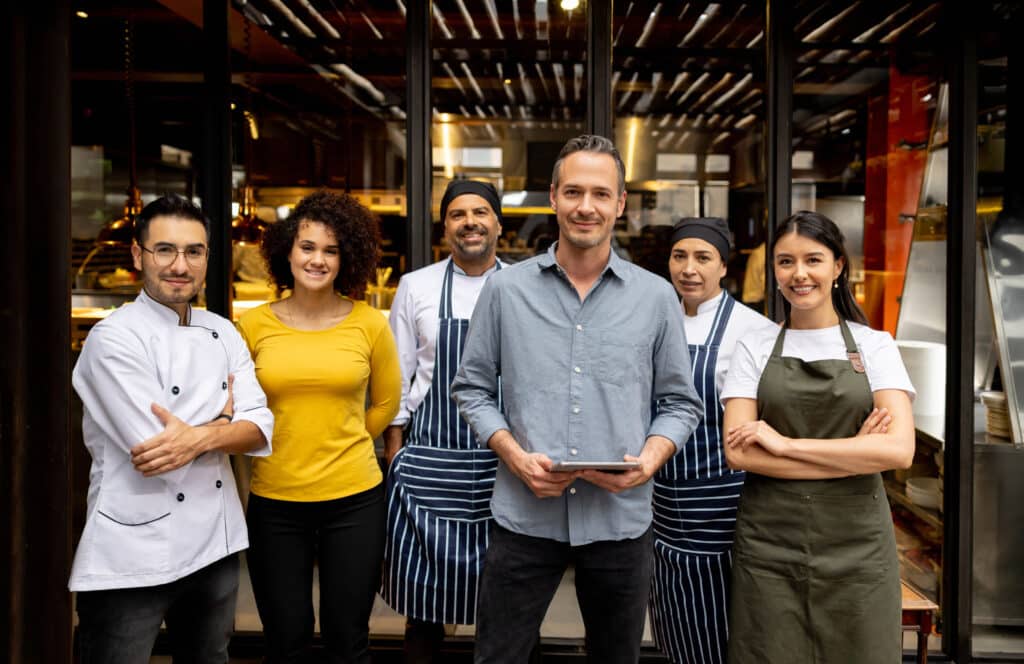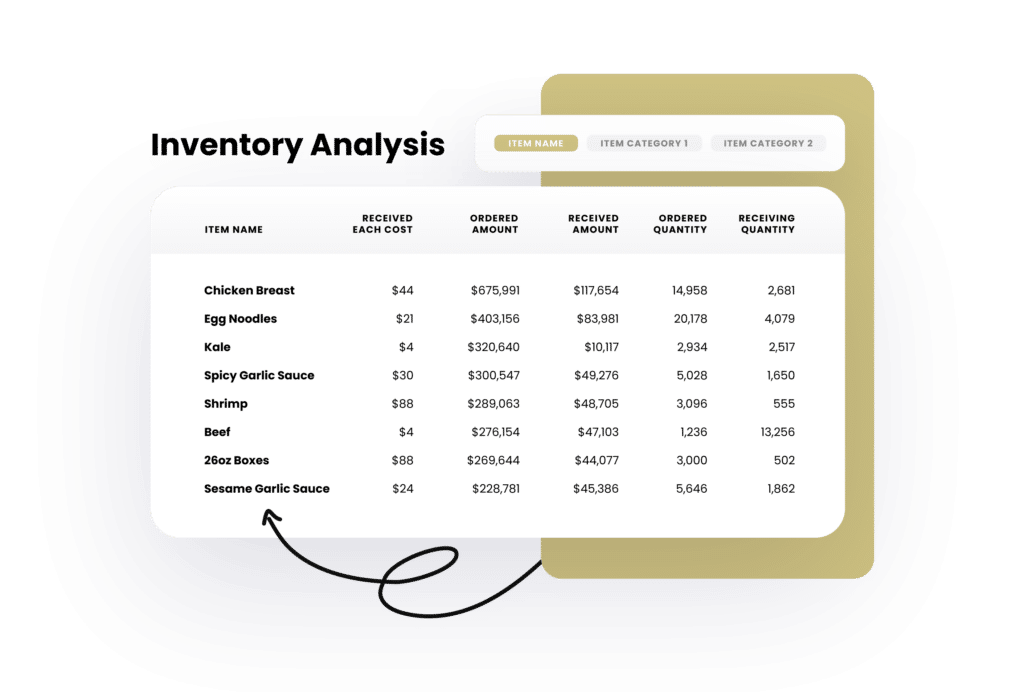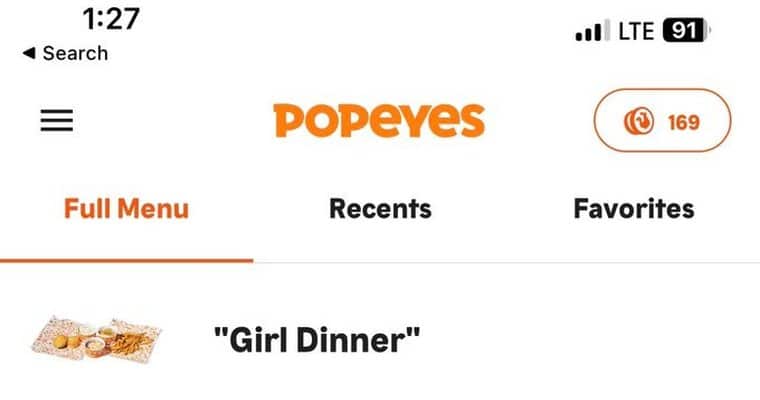By visiting our site, you agree to our privacy policy regarding cookies, tracking statistics, etc.
As a restaurant owner or operator, profitability is always a top priority. It’s not just about generating revenue; it’s about understanding the intricacies of profitability and continuously seeking ways to enhance it, one step at a time.
At the most basic level, a restaurant’s profit margin is how much an individual location, or the overall business earns after it covers all its expenses. While it’s easy to understand why operators might look for a single benchmark, a changing business climate combined with the huge variability between individual restaurants, service styles, companies, and locations makes assigning one number to such a diverse industry hard.
Below is a breakdown of the average profit margins for restaurants of various styles.
A full-service restaurant (FSR) typically includes table service and higher-touch guest experiences ranging from fine dining to a sit-down dinner. With higher labor costs, FSR can fall into the 3% to 5% profit margin range, depending on restaurant size, menu item prices, turnover rates, and location.
Fast casual restaurants, also known as fast food or quick service restaurants (QSR), involve ordering at a counter or some level of self-service. Although factors like franchise affiliation may affect profit margins, fast casual restaurants typically have an average profit margin of 6% to 9%. This profit margin reflects the lower labor costs for pre-prepared food in the kitchen and a higher table turnover rate due to faster service.
Catering businesses can come in different sizes with differing business models, but the cost of goods sold (CoGS) often remains consistent. Catering can operate with much lower overhead costs, and as such, profit margins average 7% to 8% for catering service businesses.
Calculating restaurant profit margin is like keeping a scorecard for your business. It tells you how much cash you’re pocketing from each dollar earned. Here’s how it works:
First is revenue. That’s all the money your restaurant makes from selling those delicious dishes. Next, you need to know your costs. Think of all the expenses like ingredients, rent, salaries, and utilities. Now, subtract total costs from total revenue. This is net profit.
To calculate profit margin, divide net profit by total revenue. Multiply the result by 100, and boom! You’ve got your profit margin percentage. This magic number shows you how efficiently your restaurant makes money. A higher percentage means more money to take to the bank!
One way to gauge profitability is by looking at gross profit margin.
Gross profit margin is what’s left over after selling a dish and deducting the cost of ingredients used to make it. Here’s how to calculate it:
Gross Profit = Total Sales – Cost of Goods Sold (CoGS)
Take gross profit one step further to understand menu performance better. Gross profit margin can be expressed as a percentage to see how much of every dollar earned contributes to your profit margin:
Gross Profit Margin = (Gross Profit ÷ Total Sales) x 100
While understanding gross profit margin can help you evaluate how well you’re managing food costs, it’s only part of the picture. Gross profit doesn’t include other essential operating expenses, such as labor costs, rent, and insurance.
Consider looking at your net profit margin to get a more comprehensive view of your restaurant’s financial health.
Net profit margin is based on profitability after all your operating expenses, like food cost, payroll, rent, and other operating expenses. Calculate your net profit with this formula:
Net Profit = Total Sales – Total Expenses
To understand net profit in context, calculate it as a percentage of sales.
Net Profit Margin = (Net Profit ÷ Total Sales) x 100
This number represents all the costs of running your restaurant. To get an up-to-date net profit number, you need to pull sales and accounting data from your point of sale (POS) system and restaurant accounting software. With this data, you can accurately calculate profitability.
Mastering your restaurant’s profit and loss statement (P&L) is critical, especially if running multiple locations. This report gives you the lowdown on your net income and the total financial performance for each spot.
Think of a P&L statement as a snapshot of your restaurant’s money situation over a certain period. It lays out all the cash coming in, what you’re spending on stuff like ingredients and bills, and whether you’re making a profit or taking a hit.
The great thing about a P&L is that it helps you figure out what’s working and what’s not. It’s like having a financial GPS for your business, guiding you on where to trim costs, tweak your staff scheduling, or adjust your menu prices.
A P&L can look like a lot at first glance, but don’t sweat it! Here’s a breakdown of the four main sections you’ll find in a typical restaurant P&L:
This is all about the money you bring in from selling those dishes people love. If you’ve got a modern Point of Sale (POS) system integrated with accounting software, you should be able to track sales quickly and down to dish-level details. Some P&Ls even break down sales by menu categories or food and beverage costs to give you extra insight. And don’t forget to include any comps or discounts you’re offering.
This is where the big bucks go – food and labor costs. Keeping an eye on these is crucial because they’re the biggest expenses for your restaurant. You’ve got your Cost of Goods Sold (COGS), which is how much you spend on ingredients, and labor costs, which include everything from wages to employee benefits.
Here’s some quick, easy math:
Total Cost of Goods Sold + Total Labor Costs = Prime Cost
A lot of operators contextualize their prime cost by comparing prime cost to total sales for a specific period of time, which gives you your prime cost percentage:
Prime Cost / Total Sales = Prime Cost as a Percentage of Sales
Ideally, your prime cost should be around 55% -65 % of your total sales.
Food inventory management is more than just counting items; understanding its impact on profit margins is crucial. Seamless integration among restaurant inventory software, POS systems, and accounting is vital. While POS systems track sales, they lack detailed analysis and fail to account for various inventory losses.“
These are the costs that don’t change much, no matter how busy you get. Think rent, utilities, and insurance. While you can’t do much to tweak these in the short term, it’s important to track of them.
This is the grand finale – the number that tells you how much money you’ve made (or lost) after all is said and done. It’s what’s left after subtracting your prime cost and operating expenses from your sales.
Even if your net income isn’t where you want it to be, tracking it is key. It’s the first step to improving your restaurant’s financial health. So, dive into that P&L and start steering your business toward success!

Your front of house (FOH) is where the rubber meets the road. It’s where the guests you worked so hard to bring through those doors meet the food, drink, team, culture, and operations you worked so hard to build and perfect. Like so many things, restaurants are constantly evolving, so don’t beat yourself up if things aren’t perfect the first go around. Drink glasses might be left empty for too long, a burger might be over or undercooked, and a server might be unprepared to deal with an exacting guest. The most important thing is to keep a cool head and remember your commitment to your guests, constant improvement, and your long-term goals.
As you look to bolster your FOH, remember that to improve, you need to know where you’re at. Figuring that out requires data and metrics, and getting those requires an integrated restaurant tech stack with an all-in-one restaurant management solution at its core. With this in hand, restaurant leaders can get critical performance insights that show what can be done to make guests happier and more loyal as your restaurant becomes more profitable.
Being able to get this information in real or near real time gives you, as a leader, the opportunity to dig in and ensure improvements can be made for the next guest walking in the door and all those that follow.
There are a handful of ways to gauge your customers’ experiences, including surveys, soliciting direct feedback, and, at the head of the table, social media reviews. Whenever a challenge arises, there are a handful of steps that your leaders and team should take to understand the situation, resolve it to the guest’s satisfaction, and create a plan to avoid it in the future.
Unhappy customer? Don’t let them simmer in their own stew! Get the scoop from your server, then make a beeline for that table, return that call, or hit reply on that email – pronto, but keep it cool.
Leaders or specific team members should be all over Yelp, Tripadvisor, and social media like cheese on pizza. Spot a bad review? Jump on it within a day or two, tops.
First things first, lend them your ear. Sometimes, it’s just a case of their expectations doing the tango with reality. Maybe they were celebrating something big and felt let down. Even if it’s not your fault, show some empathy.
If someone voices an issue in person, online, or in an email, it’s best, if possible, to have a real chat. Doing things digitally might be less scary, but your message can easily get muddled, making it tough to smooth things over with just a keyboard.
Keep your cool, no matter what they throw at you. People are like mirrors – if you reflect their anger or frustration, it will only make it harder to come to a positive resolution.
Messed up? Own it. Say sorry and fix it. If your server had an off day, offer the customer a free meal. But it’s not all about freebies. If their starter was cold or not right, just replace it and take it off the bill. Ran out of their favorite dish? A gift card for next time is a classy touch.
Make sure your team knows the drill. A staff trained to listen and empathize, defuse the situation, and then act is the key to flipping the script on an unhappy customer. That is not as easy as it sounds, and that’s where role-playing training comes in. But remember, training is a never-ending story. The more staff is trained, the more likely they will be able to develop good judgment skills that can pivot based on the needs of the customer and business objectives.
If your server’s done their best but it’s still not cutting it, it’s time for the manager to step in. Make sure every customer leaves feeling like they’ve been heard and helped.
Most miffed customers just walk away and never look back. If they’ve taken the time to chat about their beef, thank them and invite them back for a do-over. Throw in a little sweetener, like a discount or a freebie.
Reviews are your secret weapon for improving. Look for patterns and tackle the root cause. Dirty bathrooms? Get someone on bathroom patrol, stat. Kitchen slip-ups? It’s time for a refresher course on recipes and plating.
Alright, let’s dive into how you can entice guests to spend a bit more at your restaurant. This magic number goes by many names – price per guest, price per cover, guest average, or check average. But it all boils down to this: once a customer walks into your restaurant or places an order, how much cash are they spending? And more importantly, how much do they need to spend to make that seat worth it?
To get the lowdown on your guest average, use this simple formula:
Guest Average = Total Sales (minus taxes and tips, because those don’t count) ÷ Total Number of Covers or Orders
When analyzing this data, remember that dine-in and takeout orders are like apples and oranges – they usually have different spending patterns. Plus, you can slice and dice these numbers further by meal times, days of the week, or whether it’s a weekday or weekend.
What’s the table turnover rate, you ask? It’s all about how often your tables are filled during a certain period. More diners, more cash – simple as that. To figure out your rate, pick a time frame, count the number of parties served at each table, and divide that by the number of tables. For example, if you served 50 parties at 25 tables during Saturday’s dinner rush, your turnover rate is two.
But why stop there? Analyze this metric for different times and days and mix it up with info like reservation requests and wait times. This way, you can staff up or down as needed.
Managing food costs is a crucial part of running a successful restaurant. Food cost is a big chunk of expenses, but the good news is it’s controllable. The key is not just a one-time fix but ongoing actions by your team, especially in reducing food waste.
First, get your store-level managers on board. They need to understand the ins and outs of food costs, like actual vs. theoretical costs (AvT), FIFO (first-in, first-out) storage, and minimizing waste and errors. Training them is vital because they’re the ones who’ll lead by example in the kitchen.
Set realistic goals for your managers based on their location. Be sure they understand AvT variance, which shows the difference between what you should have spent on food and what you actually did. This can highlight waste, helping you pinpoint areas to improve.

Whether your restaurant company has one or 1,000 locations, your store-level managers are crucial for the success of each spot and the company. They’re the ones turning your company’s vision into reality, from hiring and managing staff to overseeing inventory and the guest experience.
These managers have the most impact on food and labor costs, so it’s essential to guide them towards your financial goals. Here are some ways store-level managers affect your bottom line:
High turnover is costly. Managers need to focus on hiring the best talent and retaining them from the start. This includes an efficient hiring process and a positive culture that encourages teamwork and reduces turnover.
Managers should constantly tweaking restaurant schedules to hit optimal labor numbers. They need access to sales and labor forecasting data to align scheduled hours with target labor costs and make real-time adjustments during shifts.
Accurate inventory management is key to optimizing food costs. Modern technology tools can make this process faster and more accurate, impacting profitability by reducing food waste and increasing efficiency.
Managers play a big role in the guest experience and resolving customer complaints. Tools like loyalty program apps or secret shopper programs can provide insights into how they’re doing.
Managers contribute to profit margins through employee retention, labor costs, cost of goods sold (CoGS), and guest experience. Empowering them with the right data and tools allows them to make quick, informed decisions that positively impact the restaurant’s profitability.
For effective store-level managers, communication is key. That includes strategic goals, company culture, and financial performance goals. Truly empowering store managers in all three areas requires giving them easy access to relevant data when and where it matters. Building a transparent relationship and providing the necessary tools and training will help them run their stores more efficiently and profitably.
Your restaurant continually generates valuable data from various sources such as sales revenue, food costs, and labor hours. As an owner or operator, it’s crucial to harness this data for informed decision-making.
By effectively leveraging both front of house (FOH) and back of house (BOH) data, you gain deeper insights into your operations. Without data analysis, you’re left to speculate about critical aspects like table turnover rates or inventory efficiency. By reviewing essential FOH and BOH restaurant KPIs, you can identify areas for improvement and maximize profitability. Unifying FOH and BOH data contributes to sustained restaurant profitability, enhancing long-term success.
Efficiently managing inventory and its associated costs poses a significant challenge, particularly within the multifaceted environment of the restaurant industry. However, optimizing your Cost of Goods Sold (CoGS) to control food expenses stands out as a fundamental tactic for fostering the growth of your establishment.
Implementing these strategies can yield substantial benefits in inventory management, waste reduction, and margin improvement. As these measures take effect, restaurant operators can experience a sense of reassurance as they witness a decline in the percentage of CoGS.
Count Regularly
Managing food expenses is critical for the well-being of your restaurant venture. While various strategies exist, the seven outlined methods offer a solid starting point for curbing costs and enhancing overall operational efficiency within your establishment.
Food inventory management is more than just counting items; understanding its impact on profit margins is crucial. Seamless integration among restaurant inventory software, POS systems, and accounting is vital. While POS systems track sales, they lack detailed analysis and fail to account for various inventory losses.
Dedicated inventory systems offer comprehensive tracking essential for accurate management. Best practices like integrating inventory and accounting, using forecasting tools, and recording waste are vital. Regular reviews, employee training, and leveraging technology tools enhance inventory control, boosting profitability.

Customer retention is vital in the restaurant industry, where loyal customers spend significantly more than new ones. While the average retention rate in restaurants is around 30%, focusing on retention strategies is crucial. Providing consistent high-quality experiences, ensuring well-trained staff, and offering loyalty programs are effective methods. Additionally, engaging with the community and embracing socially responsible practices can enhance brand reputation and encourage repeat business.
Reducing labor costs in restaurants requires multiple strategies, including regularly checking labor reports to identify areas for improvement, implementing predictive scheduling based on sales data and external factors, minimizing overtime through proper scheduling and training, improving employee retention with competitive benefits and rewards, and leveraging restaurant technology tools for automated tasks and data analysis. Investing in these strategies can have a significant impact on profit margins over time.
The restaurant industry is grappling with a persistent worker shortage, making employee retention crucial for staffing stability. Implementing effective retention strategies is key, including hiring the right employees, transparent interviews, referral bonuses, competitive benefits, consistent pay raises, career development paths, relationship-building, schedule flexibility, and exit interviews to identify root causes of turnover. By prioritizing retention, restaurants can mitigate staffing challenges and foster a more stable workforce.
Menu engineering is an effective strategy to optimize restaurant profitability by emphasizing high-margin items and guiding customer orders. It utilizes sales data and recipe costing to assess demand and margin contribution. Automation streamlines this analysis, enabling informed decisions on pricing, portioning, and menu placement. By identifying menu opportunities, like promoting lucrative but underperforming items, restaurants can enhance profitability. Dashboards offer detailed sales insights and monitor server performance, facilitating effective training for suggestive selling.
Strategic menu planning is crucial for restaurants facing rising food and labor costs. Analyzing sales reports and prioritizing profitable items through a menu mix matrix are essential steps. Managing prime costs, such as COGS and labor, ensures efficient resource use and precise menu pricing, while integrating technology like POS with inventory and recipe costing software provides valuable insights for better decision-making.
Understanding the popularity and profitability of menu items is vital for business growth. Integrating a restaurant management system with POS and inventory data enables real-time insights into business performance. This empowers leaders to prioritize profitable items and optimize margins for every menu item.
QR code menus provide various advantages for restaurants, including efficiency, cost reduction, and increased profitability. They eliminate disposable menus, enhancing cost efficiency and environmental sustainability. QR Code menus also streamline operations with quick ordering and enable easy updates and detailed analytics. Additionally, they offer opportunities for upselling and cross-selling, contributing to increased revenue.
The great thing about a P&L is that it helps you figure out what’s working and what’s not. It’s like having a financial GPS for your business, guiding you on where to trim costs, tweak your staff scheduling, or adjust your menu prices. ”
Now more than ever, it’s essential for restaurant operators to utilize every tool at their disposal to gain an advantage and improve profitability. Leveraging advanced restaurant management technologies such as cloud-based POS systems and labor optimization software can enhance efficiency, while customer-facing technologies like contactless payment and mobile ordering apps can drive repeat business and reduce employee turnover, contributing to increased profitability and growth in the industry. Here’s a look at some restaurant technology you can use to grow your restaurant business.
R365 Accounting is a leading restaurant accounting software designed to enhance margins and scalability by integrating seamlessly with POS systems and offering direct general ledger connection, accounts payable automation, and real-time reporting. Features include automated accounts payable processes, modern banking integration for real-time financial transaction tracking, fixed assets tracking, smart budgeting and forecasting tools, customizable financial reporting for monitoring financial health, and efficient restaurant bookkeeping workflows.
R365 Store Operations provides an integrated solution for restaurant management, featuring real-time inventory management, automated purchasing, forecasting, food costing controls, data-driven scheduling, and shift-to-shift communication. This tool allows you to automate inventory processes, optimize purchasing, manage commissary operations, create recipes, track daily activities, forecast accurately, and schedule labor strategically across multiple locations.
R365 Workforce provides a wide range of tools to improve restaurant efficiency and manage the employee lifecycle effectively. It encompasses functions such as hiring, onboarding, scheduling, payroll, benefits administration, and tip automation. Users can efficiently attract and track candidates, optimize onboarding procedures, ensure accurate payroll processing, automate tip handling, manage HR tasks proficiently, simplify scheduling, and streamline benefits administration with precision and simplicity.
R365 Intelligence offers dynamic data solutions to empower restaurant growth. It provides real-time insights, better benchmarking, data visualization, data dashboards, and collaborative reports. Users can compile and compare various data sets effortlessly, develop strategies to reduce costs, visualize critical data intuitively, build customized dashboards, and empower teams with automated reports and subscriptions.
Implementing a restaurant reservation system provides multiple benefits, including quicker table turnover, improved forecasting and scheduling, collection of customer preferences and food allergies, and enhanced marketing capabilities through customer information capture. These advantages contribute to a smoother operation, better customer experience, and increased profitability.
AI, including ChatGPT, serves as an asset to the restaurant industry by complementing rather than replacing human interaction. It helps fill labor shortages and automates repetitive tasks, freeing up time for operators to enhance customer experiences and drive growth. Embracing AI is crucial for staying competitive and efficient in today’s rapidly evolving technological landscape.

Restaurant finance and accounting leaders play a crucial role in supporting operations by optimizing revenue and controlling expenses. Finance teams can provide insights into operational efficiency, prime cost goals, food cost inefficiencies, labor productivity goals, and revenue optimization strategies. By leveraging data-driven approaches and collaborative efforts, restaurant finance teams can help operations make informed decisions, streamline processes, and drive revenue growth.
A well-executed online marketing strategy for restaurants can enhance brand visibility, attract new customers, and improve customer retention, all of which are crucial for boosting sales and profitability. Establishing a strong online presence is key to the success of your restaurant’s marketing efforts.
Creating a marketing plan doesn’t need to be complex. Start by implementing simpler tactics gradually, and as you become more confident, expand your marketing strategies accordingly.
Social media advertising is essential for restaurants, as it’s the second most trusted information source for consumers deciding where to dine. To maximize effectiveness, restaurants should create engaging content, interact with customers, leverage user-generated content, and run promotions. Joining local groups, expanding to platforms like Instagram and Twitter, tagging locations, and engaging with followers are all recommended strategies for restaurants promoting their brand on social media.
To capitalize on viral food trends, operators can consider creating dedicated menus, using promotional tools like chalkboards or QR codes, and offering limited-time specials to encourage sales. Including these items in happy hour menus can entice customers to try them at lower prices. Overall, experimenting with new menu items, when priced and promoted effectively, can lead to increased profits and customer engagement.

Implementing SEO strategies is essential for restaurants to attract customers, as most consumers prefer restaurants from the first page of Google. Key tips include using localized keywords, managing local listings, ensuring consistency in online directories, soliciting reviews, creating engaging experiences, and optimizing website performance. Mastering SEO is vital for restaurant owners to compete online and drive revenue growth.
Achieving long-term restaurant profitability isn’t about finding a quick fix. It involves implementing a range of strategies across your operations. Fortunately, many of these strategies not only enhance efficiency but also contribute to increased profitability. While long-term success demands ongoing commitment, leveraging the right tools can help your restaurant achieve its objectives at every stage – be it short, medium, or long term.
If your restaurant business is focused on long-term profitability, equip your team with tools that will help increase operational efficiency. Restaurant365 is an all-in-one restaurant management system incorporating restaurant accounting software, restaurant operations software, inventory management software, payroll + HR software, and scheduling software into a cloud-based platform that’s fully integrated with your POS system, as well as to your food and beverage vendors, and bank.
Share this blog:
See why more than 40,000 restaurants use Restaurant365
500 Technology Drive, Suite 200
Irvine, CA 92618
Westech 360
8911 N Capital of Texas Hwy
Building 1, Suite 1200
Austin, TX 78759
Restaurant365 bridges the gap between accounting and operations by centralizing all data, helping restaurant operators to become more efficient, accurately forecast, and tackle any challenge or opportunity with speed and accuracy.